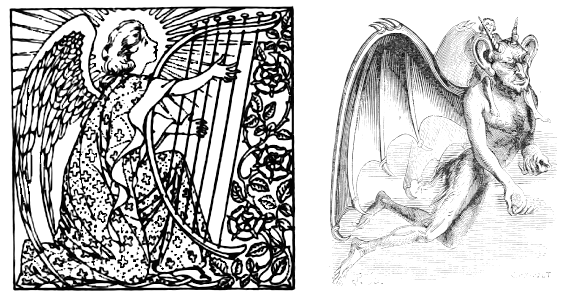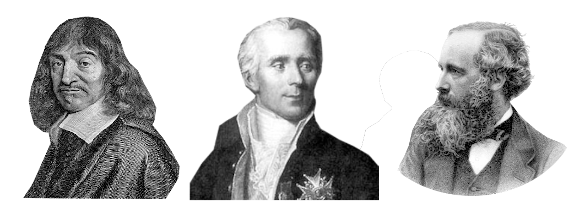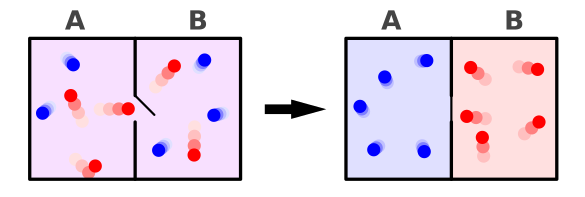Demons in Science
January 25, 2021
The
supernatural beings known as
angels are a part of many
religions, and they are mentioned often in the
Bible and other
Judeo-Christian religious texts. Their function is to relay the intentions of
God to
humans, and the
word, angel, derives from the
Greek word, ἄγγελος, angelos (messenger). The number of angels, as stated in
Revelation 5:11, is ten thousand times ten thousand, or 100 million.

An angel (left) and a demon. Angels are often depicted playing a harp. Popular culture says that the fiddle is the devil's musical instrument. (Left image, an angel from The Celestial Country, a 1900 publication by Edwin S. Gorham; right image, an 1863 illustration by Louis Le Breton (1818-1866) from Tables tournantes dans le Dictionnaire infernal par Collin de Plancy; both from Wikimedia Commons)
While every
experimenter hopes that a
guardian angel is assisting him in his
experiments, there are no specific angels mentioned in the
scientific literature. There are, however, a few
demons, and these are discussed in a recent book,
Bedeviled: A Shadow History of Demons, by
Jimena Canales.[1] This book was
reviewed in a recent issue of
Science by
Jan G. Michel of the
Department of Philosophy of Religion and Science,
Ruhr-Universität Bochum (Bochum, Germany).[2]
Alphonso de Spina (fl. 1500), a
Spanish Franciscan Catholic bishop, somehow determined that the number of demons was 133,316,666. This number is nearly a factor of five too large, if we believe that the
traditional number of demons is one third of the angels.
Paradise Lost, a 1667
epic poem by
John Milton (1608–1674), states that
Satan, in his
rebellion against God, "Drew after him the third part of Heaven's host."[3] The most famous
quotation from Paradise Lost is Satan's declaration, "Better to
reign in
Hell than
serve in
Heaven."
In
Bedeviled: A Shadow History of Demons, Canales writes about three principal demons relating to
science; namely,
Laplace's demon,
Maxwell's demon, and
Descartes' demon. Laplace's demon, as imagined by
French polymath,
Pierre-Simon Laplace (1749-1827), has knowledge of the precise location and
momentum vector of every
atom in the
universe. This
knowledge allows a
calculation of any future state of the universe according to the
laws of
classical mechanics. There have been many arguments for why this demon would not be successful in its calculations. We can't invoke
quantum mechanics, since the realm of the question is the classical mechanics known to Laplace. Furthermore, we can't invoke
chaos theory, since all quantities are supposedly known to adequate
precision.

Three demon masters, René Descartes (1596-1650), Pierre-Simon Laplace (1749-1827), and James Clerk Maxwell (1831-1879), responsible for the eponymous Laplace's demon, Maxwell's demon, and Descartes' demon. (Portrait of René Descartes by Gérard Edelinck from a bust by Frans Hals (left), image of Pierre-Simon Laplace (center), and an engraving of James Clerk Maxwell by G. J. Stodart from a photograph by Fergus of Greenock (right) all from Wikimedia Commons.)
The most plausible reason for the impossibility of Laplace's demon's success is the
computational power required. All
computation requires a
memory of a calculation's intermediate terms, and the universe has a limit on
information content. This limit amounts to 10
120 bits, a number derived from
fundamental physical constants, and this would be the minimum size of a computation for
simulating the universe.[4-6] That number, combined with the limitation imposed by the
speed of light on information transfer, requires that any computation that needs more data than this can't be done in less time than the
age of the universe. This presumes that the demon is bound by the
laws of physics, a necessary condition; otherwise, anything would be possible.
Maxwell's demon is a part of a
thought experiment devised in 1867 by
physicist,
James Clerk Maxwell (1831-1879). In this thought experiment, a demon violates the
second law of thermodynamics, the law concerning
entropy that proves that a
perpetual motion machine can't function by extracting
environmental thermal energy to produce
mechanical work.
The demon controls a
door between two
gas-filled
chambers. He opens the door to allow only faster (hotter)
gas molecules to enter one chamber, and only slower (colder) gas molecules to pass into the other. Maxwell's demon can't function as envisioned, since he's a part of the
thermodynamic system. He creates more entropy than he could ever eliminate in doing his task, since the act of acquiring information on
molecular speed expends energy.

Principle of Maxwell's demon. The door separating the two chambers opens to allow only hot gas molecules to pass from A to B, and cold molecules to pass from B to A. (Modified Wikimedia Commons image by Htkym.)
Descartes' demon acts in a way that
precludes any
scientific truth. As imagined by French
mathematician,
scientist, and
philosopher,
René Descartes (1596-1650) in his 1641
Meditations on First Philosophy, this demon presents to men a complete
illusion of an
external world. As Descartes writes, "I shall consider myself as not having
hands or
eyes, or
flesh, or
blood or
senses, but as falsely
believing that I have all these things." You might see an
analogy of this with the recent idea that
we are part of a computer simulation.
Descartes dismisses this idea by stating, "je pense, donc je suis," which is most commonly rendered as
cogito, ergo sum; that is, "I think, therefore I am." The reasoning is that such
self-awareness could not be manipulated. This idea was earlier stated around
500 BC by
Parmenides of Elea (fl. late sixth - early fifth century BC). Parmenides wrote in his book,
On Nature, in the section known as
the way of truth, "For it is the same thing that can be thought and that can be."[7]

"For it is the same thing that can be thought and that can be." A portion of On Nature by Parmenides of Elea. (From Ref. 7.)[7]
While on the topic of demons, we should also address the interesting question of which place is hotter, heaven or hell. Heaven is often associated with a bright
white light, while hell is a place of
fire and brimstone, brimstone being an
archaic term for
sulfur. The
melting point of sulfur is 115.21
°C (388.36
K, 239.38
°F), and its
boiling point is 444.6 °C (717.8 K, 832.3 °F), so
burning sulfur can have a
temperature between those extremes (assuming
atmospheric pressure). The temperature of a
blackbody emitting white light is 5,225°C (5,500 K, 9440.33 °F).
References:
- Jimena Canales, "Bedeviled: A Shadow History of Demons in Science," Princeton University Press, November 10, 2020, 416 pp., ISBN: 978-0691175324 (via Amazon).
- Jan G. Michel, "Imaginary demons and scientific discoveries," Science, vol. 370, no. 6518 (November 13, 2020), p. 772, DOI: 10.1126/science.abd9851.
- John Milton, "Paradise Lost," at Project Gutenberg.
- S. Lloyd, "Ultimate physical limits to computation," Nature, vol. 406, pp. 1047-1054 (August 31, 2000). https://doi.org/10.1038/35023282.
- Seth Lloyd, "Computational Capacity of the Universe," Phys. Rev. Lett., vol. 88, Article no. 237901, May 24, 2002, DOI:https://doi.org/10.1103/PhysRevLett.88.237901.
- J.R. Minkel, "If the Universe Were a Computer," Physical Review Focus, vol. 9, no. 27 (May 24, 2002).
- Parmenides, "Fragments," Original Greek text by Diels, English translation by John Burnet, PDF File from Philoctetes.
Linked Keywords: Supernatural being; angel; religion; Bible; Judeo-Christian; religious text; God; human; word; Greek language; Greek word; Book of Revelation; demon; harp; The Devil Went Down to Georgia; Popular culture; fiddle; devil; musical instrument; Louis Le Breton (1818-1866); Wikimedia Commons; experiment; experimenter; guardian angel; scientific literature; Jimena Canales; book review; Science (journal); Jan G. Michel; Department of Philosophy of Religion and Science; Ruhr-Universität Bochum (Bochum, Germany); Alphonso de Spina (fl. 1500); Spain; Spanish; Franciscan; Catholic Church; bishop; tradition; traditional; Paradise Lost; epic poem; John Milton (1608–1674); Satan; rebellion; quotation; reign; Hell; commoner; serve; Heaven; science; Laplace's demon; Maxwell's demon; Descartes' demon; France; French; polymath; Pierre-Simon Laplace (1749-1827); momentum vector; atom; universe; knowledge; calculation; physical law; classical mechanics; quantum mechanics; chaos theory; precision; René Descartes (1596-1650); Pierre-Simon Laplace (1749-1827); James Clerk Maxwell (1831-1879); eponym; eponymous; Gérard Edelinck; Frans Hals; G. J. Stodart; Fergus of Greenock; Moore's law; computational power; computation; computer memory; information; bit; fundamental physical constant; computer simulation; speed of light; age of the universe; physical law; laws of physics; thought experiment; physicist; second law of thermodynamics; entropy; perpetual motion machine; environment (biophysical); environmental; thermal energy; work (physics); mechanical work; door; gas; environmental chamber; gas molecule; thermodynamic system; kinetic theory of gases; molecular speed; principle; Htkym; preclude; science; scientific; truth; mathematician; philosopher; Meditations on First Philosophy; illusion; reality; external world; hand; eye; flesh; blood; sense; belief; believing; analogy; simulated reality; we are part of a computer simulation; cogito, ergo sum; self-awareness; 500 BC; Parmenides of Elea (fl. late sixth - early fifth century BC); On Nature; white light; fire and brimstone; archaism; archaic term; sulfur; melting point; Celsius; °C; kelvin; K; Fahrenheit; °F; boiling point; combustion; burning; temperature; atmospheric pressure; black-body radiation; blackbody.